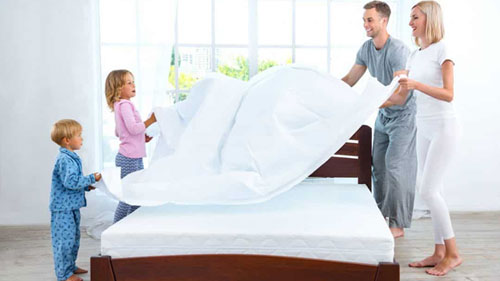
Choosing a mattress is not an easy task. Extensive product research on price, material composition, and other factors is required. Since a comfortable mattress is essential for a good night’s sleep, the matter should not be taken lightly.
The better informed we are about our sleep patterns and preferences, the easier it is to navigate. Aside from general factors like size, firmness, and thickness, we should take into account the following:
1. The type of sleeper
Back sleeper – A medium-firm or firm mattress that provides ample spine alignment necessary for the back is advised.
Side sleeper – Mattresses that take the shape of body contours and provide support to the stress points around hips and shoulders are most suitable for this sleeping style.
Stomach sleeper – Mattresses that support and cushion the midsection while ensuring the spine remains aligned are appropriate for people who sleep on their stomachs. These mattresses should neither be too soft nor too firm.
Toss and turn sleeper – For people who roll over in their sleep, a mattress with a motion transference feature is recommended. Such mattresses ensure undisturbed sleep by containing motion and keeping it from traveling across the bed. Motion transference is particularly necessary for those who sleep with a partner. A mattress that manages motion transfer can ensure that sleeping partners do not interrupt one another when they shift about at night.
2. Budget
The price of mattresses is dependent on the size, model, brand, and material. Therefore, it is vital to choose a bed that caters to one’s requirements without going past the allocated budget.
3. Material
Innerspring mattress – The presence of coils in these mattresses provides strong support and a bouncy feel.
Latex mattresses – Compared to an innerspring mattress, the latex option offers more responsiveness and bounce.
Memory foam – These mattresses relieve pressure as they contour to the body.
From straightforward innerspring mattresses to memory foam mattresses, the options available today are diverse. Familiarizing oneself with each model’s attributes and weighing in the pros and cons is essential in making a decision concerning mattresses. Allergies should also be factored in when choosing the material of the bed.
4. Body pain
Research has shown that a medium-hard bed, rather than a firm one, is the safest option for lower back pain. It is always better when the head, neck, and spine are in neutral alignment. A position contrary to this can cause stiffness and aches upon waking up. Mattress retailers claim that memory foam mattresses allow for better spinal alignment, which can be great for back pain.
5. Durability
A mattress is a significant investment for most people. Therefore, ensuring its durability is necessary. Mattresses that are made of high-quality fabrics and well-constructed easily outlast cheaper options.
With the various options available today, we can narrow down our list by considering the aforementioned aspects. Seeking honest feedback from individuals who have purchased the product we are interested in can be helpful. It is always recommended to try out the mattress at the store to ascertain its firmness and support.




